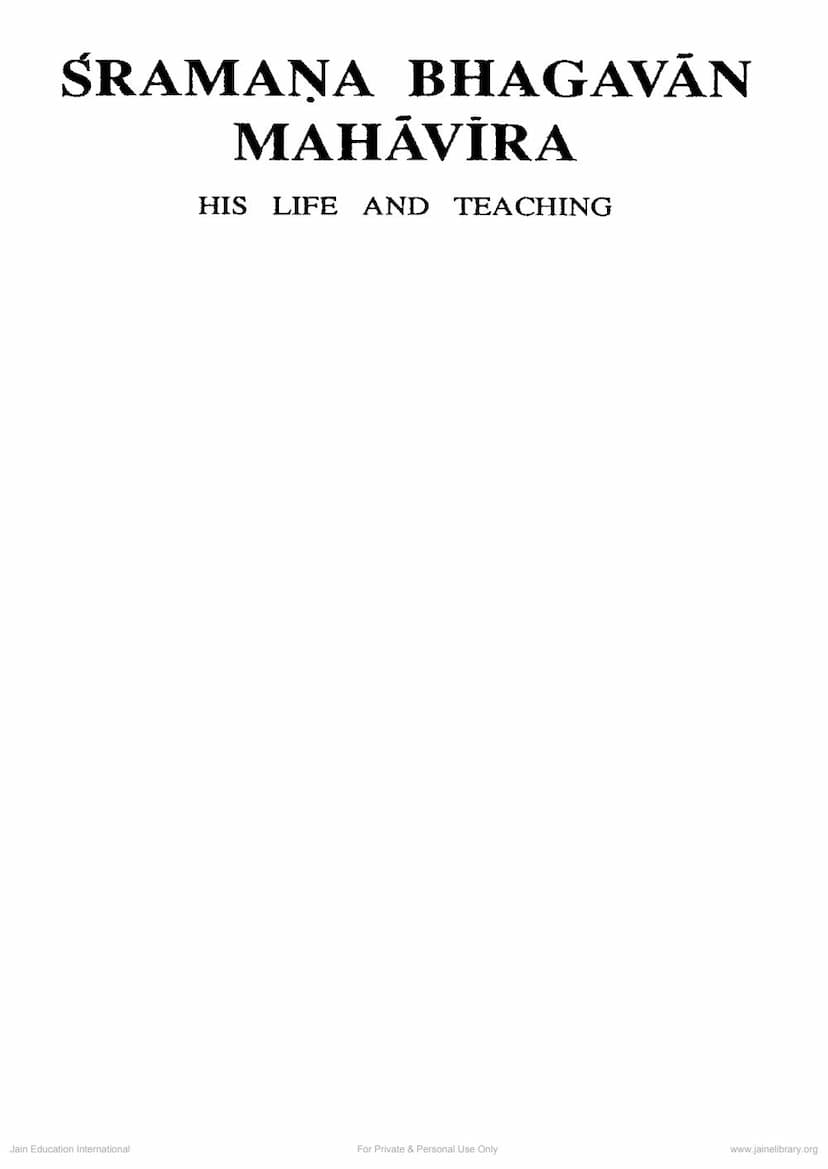Shraman Bhagvana Mahavira Part 4
Added to library: September 2, 2025

Summary
Summary of "Śramana Bhagavān Mahāvīra: His Life and Teaching, Volume IV: Nihnava-Vāda"
This volume, part of a comprehensive series on Bhagavān Mahāvīra, delves into the philosophical debates and divergent viewpoints within Jainism, specifically focusing on the concept of Nihnavavāda. The text, authored by Muni Ratnaprabh Vijaya and D.P. Thaker, and published by Parimal Publications, aims to provide a detailed analysis of these historical controversies, highlighting the lives and teachings of individuals who deviated from the orthodox Jain canons, known as Nihnavas.
Key Themes and Content:
-
The Jain Canon and its Preservation: The preface emphasizes the foundational role of Rishabhadeva, the first Tirthankara, in establishing the Jaina Canon. It traces the evolution of these sacred works, acknowledging their increase in number and quality after Rishabhadeva, followed by a reduction during periods of disorder. The text highlights the gradual fading of the absolute knowledge of Mahāvīra's preachings among his Ganadharas and subsequent generations of Śruta-Kevalins and Daśapūrvis, culminating in the eventual need to commit these teachings to writing, resulting in the forty-five Agamas.
-
The Avaśyaka Sūtra and Viseṣāvaśyaka Bhāṣya: The volume underscores the paramount importance of the Avaśyaka Sūtra, one of the four Mūla Sūtras, guiding Jain monks in their religious practices. It introduces the Viseṣāvaśyaka Bhāṣya, a commentary by Jinabhadragaņi Kşamāśramaņa, which elucidated the original Niryukti on the Avaśyaka Sūtras. This extensive work, comprising 3603 verses, is divided into several sub-sections, with Gaṇadharavāda and Nihnavavāda being the most crucial as they discuss philosophical topics both positively and negatively, vital to the Jaina Āgamas.
-
Gaṇadharavāda vs. Nihnavavāda: A significant portion of the introduction contrasts these two vādas.
- Gaṇadharavāda: Characterized by positive discussion, strengthening Jaina Āgamas by asserting cardinal virtues. Debates are based on interpretations of Voda-vacanas, and Gaṇadharas engage in dialogue with Mahāvīra himself, driven by a quest for truth and leading to their eventual acceptance of his principles.
- Nihnavavāda: Characterized by negative discussion, attempting to repudiate Jainism's core tenets, thereby weakening its influence. Debates are based on interpretations of Jaina Āgamas, and Nihnavas often argue with preceptors of various Gacchas. They are driven by jealousy, anger, vanity, or infatuation, and often cling to their rigid beliefs despite strong arguments. Their discussions, rooted in insinuation of truth, aim to hide truth and establish their own theories, causing disruption. Nihnavas are often learned Jaina monks who abandon the faith to establish their own schools.
-
The "Nihnavas" and their Theories: The core of the volume is dedicated to detailing the lives, theories, and controversies surrounding various Nihnavas. The text systematically presents the story of each Nihnava, their unique philosophical departures from Jainism, and how they were either refuted or how their theories influenced the Jain tradition. The Nihnavas discussed include:
- Jamāli: A relative of Mahāvīra, who questioned the concept of "kriyamāņa kritam" and proposed the theory of 'bahurata' (long duration of time for actions).
- Tişyagupta: A student of a Śruta-Kevalin, who misinterpreted the definition of Jiva, proposing that only the last pradeśa constitutes the soul.
- Ārya Āsādhācārya: Pioneer of the 'Avyakta' (doubtful) theory, stemming from the uncertainty of the ascetic state.
- Ārya Aśvamitra: Advocated the theory of 'Kṣaṇikakṣaya' (momentary destruction), postulating the complete destruction of all beings.
- Ārya Gaṅgācārya: Propounded the theory of 'Dvaikriyā' (two simultaneous actions).
- Rohagupta: Pioneer of the Vaiśēṣika system, known for his theory of three categories (Jiva, Ajiva, and Nojiva).
- Goṣṭhā-Māhila: Contradicted the principle of 'pratyākhyāna' (vow of renunciation) and its time limit.
- Boţika (Digambaras): A peculiar sect that gave rise to the Digambara tradition, stemming from Śivabhūti's practice of nudity.
-
Utility of Nihnavavāda: Despite their detrimental impact, the text acknowledges the indirect strengthening of Jainism through Nihnavavāda. These intellectual debates served to test the real essence of religious precepts, making the lustre of the Jaina Canon brighter. Nihnavas also served as a cautionary tale, warning followers of the disastrous consequences of deviating from established doctrines. Their existence also highlighted the human tendency towards hypocrisy and inconsistency, prompting introspection. The study of Nihnavavāda also cultivated intellectual robustness, encouraging critical acceptance of truths only after rigorous testing.
-
The Author and Commentators: The volume also provides information about the author, Jinabhadragaņi Kşamāśramaņa, recognizing him as a "Yugapradhāna" (leader of an era) for his scholarly interpretations and logical explanations. It also mentions prominent commentators like Kotyācārya and Maladhāri Hemacandrācārya, whose works significantly contributed to the understanding of Jain philosophy.
-
Detailed Discussions and Debates: The book then proceeds to detail the arguments and counter-arguments of the Nihnavas and their interlocutors, often drawing from scriptural sources like the Bhagavati Sūtra and Ācārānga Sūtra. Each chapter is dedicated to a specific Nihnava, outlining their life, the origin of their divergent views, and the refutations presented by the orthodox Jaina scholars.
In essence, "Śramana Bhagavān Mahāvīra, Volume IV: Nihnava-Vāda" offers a scholarly exploration of the internal philosophical struggles and intellectual debates within Jainism. It provides valuable insights into the development of Jain thought, the challenges faced by its traditional doctrines, and the rigorous intellectual engagement employed by its scholars to preserve and elucidate its core principles.